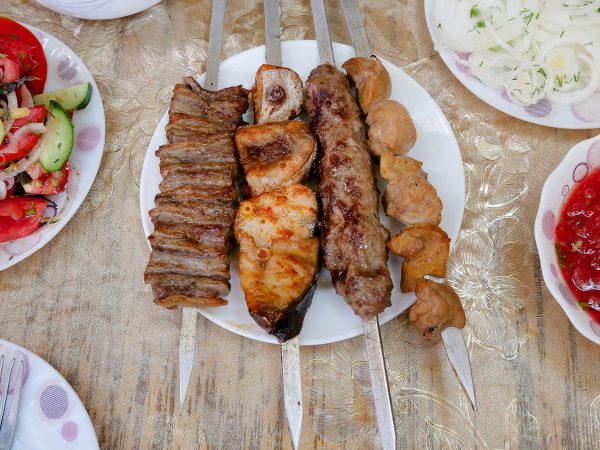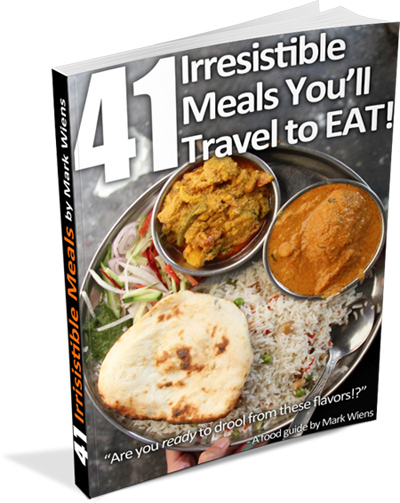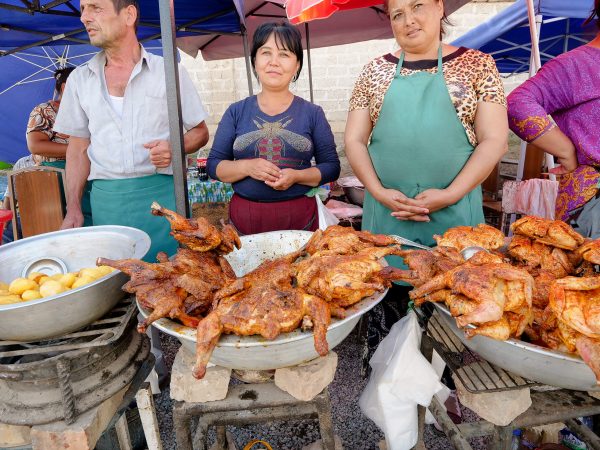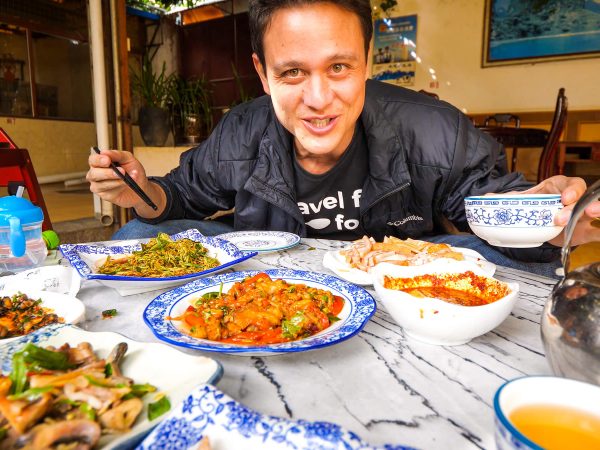
Bhutanese food is un-like any other food you’ll ever eat.
In this blog post I’m going to share with you 25 of the best Bhutanese foods. So prepare yourself to dive deep into the amazing (and little known) cuisine of Bhutan!

First, what is Bhutanese food?
I’ll be completely honest with you:
Before going to Bhutan, I had no clue what Bhutanese food was. I automatically assumed it would be similar to Nepali cuisine, or similar to Naga food. But eating my first Bhutanese meal in Thimphu, I found out I was quite wrong.
Watch the Bhutan videos here
If you have some time, press play to watch my entire Bhutan video series, showing you the food and culture of Bhutan.
(Or you can watch it on YouTube here)

I had a chance to spend about a month eating my way through Bhutan — from dried yak coated in fermented yak cheese to complex chili sauces made with over thirty ingredients and spices — all of which I’m excited to share with you.
You’ll be impressed by how unique and delicious Bhutanese food is.

When you’re in Bhutan you’ll eat a range of Bhutanese, Tibetan, Nepali, and Indian food, which are all very common and well represented throughout Bhutan.
However, for the purposes of this list, I’ve tried to stick pretty much to authentic Bhutanese food dishes, although there are definitely some crossovers, especially with Tibet.
Anyway, I hope you enjoy this post, and if you ever have a chance to try Bhutanese food, please try it out — you’ll be in for a memorable food experience.

1. Ema datshi
We’ll start off with the most famous Bhutanese food of them all: ema datshi, which is chilies and cheese.
You’ll eat ema datshi not only everyday when you’re in Bhutan, but likely for just about every meal when you’re in Bhutan. The chilies, which can be either fresh green chilies or dry red chilies, are sliced lengthwise, and cooked with datshi, which is local Bhutanese cheese, and plenty of butter for good measure.
Although the basic ingredients remain the same, the more you eat ema datshi, the more you’ll realize that no two ema datshi’s are the same: every cook has their own version, some being lighter or more watery, others being richer and more sticky with cheese.

2. Kewa datshi
Kewa is potato, so kewa datshi is potatoes and Bhutanese cheese. It surprised me by how similar kewa datshi is to a dish similar to scalloped potatoes.
The potatoes are typically sliced into thin pieces, then sautéed down with cheese and lots of butter. Sometimes cooks will toss in a few chilies or tomatoes, but usually, this is a Bhutanese dish that’s pretty mild, but just focuses on potatoes and cheese.

3. Shamu datshi
A third staple cheese dish in Bhutanese food is shamu datshi, cheese with mushrooms.
Being a chili addict, ema datshi is my personal favorite variation of a Bhutanese veggie cheese dish, but shamu datshi was a close second. The mushrooms, which can be any variety of local Bhutanese Himalayan mushroom, are again, cooked into a cheesy saucy stew along with butter.
Just like with all the other variations of Bhutanese datshi, you eat shamu datshi along with rice.

4. Shakam ema datshi
If you haven’t already noticed, there’s just about no way you can go to Bhutan and eat Bhutanese food without eating lots of cheese. Datshi will probably one of the first words you learn in Dzongkha.
Shakam is Bhutanese dried beef, which is among the most famous of meats. The beef is dried and preserved so it tastes similar to beef jerky, but thicker, and not quite completely dehydrated.
For shakam datshi, dried beef is cut into bite sized pieces and simmered with cheese and butter. What a combo this is.

5. Shakam paa
Shakam paa is a wonderful Bhutanese food of dried beef cooked with dried chilies and sometimes slices of radish.
During my month staying in Bhutan, shakam paa quickly became one of my favorite protein dishes of choice. Again, the beef is slightly chewy from being dried and preserved, and it’s combined with lots of dry chilies.
One thing I loved about Bhutanese cooking is how the chilies are just tossed in whole — don’t worry about slicing things up and making them look pretty — you get the whole chilies in Bhutan, amazing.

6. Shakam shukam datshi
Shakam shukam datshi is a rather rare dish that you won’t find at too many restaurants in Bhutan, but when I had it for the first time at a local restaurant in Thimphu, I immediately fell in love with the combination and especially with the unique white chilies.
You probably recognize shakam and datshi already — chilies and cheese — but shukam are Bhutanese dried white chilies. So this Bhutanese dish includes cuts of dried beef cooked with cheese and white chilies. The white chilies ad an incredible sour spice which is quite unique.

7. Phaksha paa
Along with beef and yak, pork is also widely loved throughout Bhutan, perhaps the most of all meats.
For phaksha paa, slices of pork are stir fried with whole red dry chilies and sometimes some mountain vegetables as well. The result is another staple Bhutanese dish that goes great with rice and mixed in with some datshi dishes.

8. Sikam paa
Do you love bacon? Sikam paa is like bacon on the next level, and from my experience, this is a dish that many Bhutanese love with passion.
You’ll see strands of half transparent pork belly hanging in the sun to dry — that’s sikam. The pork, which has quite an impressive ratio of fat, is dried in the sun. For sikam paa, the dried pork belly is then is fried up with dried chilies.
I have to admit, sikam paa was pushing my oily food limits meter when I was in Bhutan. But a small piece at any meal, plus a bunch of the dry chilies, was what I most enjoyed about this famous Bhutanese dish.

9. Yaksha shakam
If there’s a meat that can be argued as better than dried beef, it’s dried yak meat. Yak is similar tasting to beef, but it has a little bit of a different fragrance (without being too gamey), and it supposedly is quite nutritional.
For yaksha shakam, the yak meat is dried into a jerky like meat and it can be cooked in a number of different ways. One of the best versions of dried yak meat that I ate in Bhutan was dried yak cut up and cooked with fermented yak cheese. It was a Bhutanese dish of dreams.

10. Goep
If you love tripe, goep in Bhutan, slices of tripe stir fried with dried chilies, green onions, and sometimes small vegetables, is an excellent dish.
Just like so many other famous Bhutanese dishes, what I liked most about eating g0ep in Bhutan are all the dried chilies that are included in this dish. The tripe can be a little on the chewy side, but that’s the real texture of tripe.

11. Juma
Juma is a type of common Bhutanese sausage made with minced meat, rice, and some light spices all filled into an intestines wrapper.
The first thing I could taste on my first bite of juma was the wonderful citrusy zing of Sichuan pepper. Other than that, most versions of Bhutanese juma I tasted were a little plain tasting, but very meaty.

12. Gondo datshi
Butter egg fry, or gondo datshi, is like the ultimate Bhutanese scrambled eggs you can imagine.
Eggs, are scrambled up with datshi cheese, and a huge amount of butter, and in some cases small bits of dried chili. The result is a very condensed scrambled egg cheese mixture that is fragrant from butter and packed with heartiness.
If you have some Bhutanese butter egg fry, some chili sauce and a mound of Himalayan red rice, you’re in for a wonderful simple meal.

13. Jasha maru
Jasha maru is Bhutanese chicken stew, or sometimes called a chicken curry.
One of the tastes I love so much about Bhutanese jasha maru is the noticeable ginger taste, that nearly every version of the dish had that I tried. The actual dry spice flavor is quite mild, but the ginger is what really gives this dish its essence.

14. Momos
Momos are dumplings that are popularly eaten from India to Nepal to Bhutan and known as a Tibetan food – basically the entire Himalayan region – and even broader, they are very similar to any type of dumpling around the world, probably originating from China.
Momos are easily the most common of all restaurant and street food snacks that you’ll find in Bhutan. They are served piping hot, filled with minced meat, cheese, or vegetables, and consumed with lots of Bhutanese chili sauce known as ezay.
You can get momos freshly steamed or also deep fried momos, which are fried in oil after being steamed. Let’s just say, you’ll be in no short supply of momos when you visit Bhutan.

15. Hoentay
Known especially for originating from Haa Valley in Bhutan, hoentay are similar to momos, but they are made with a buckwheat dough wrapper. The dumplings are usually filled with a combination of a local spinach or turnip leaves and cheese, and again, they can either be steamed or fried.
When I was in Haa Valley for a few days, I enjoyed numerous plates of hoentay, which are hearty and filling, and are especially good when drowned in Bhutanese chili sauce (ezay).

16. Lom
Due to the harsh winter conditions in many areas of Bhutan, vegetables can sometimes be scarce in the winter. Lom, which are turnip leaves, are one of the few vegetables that can be dried and preserved and eaten throughout the year. The actual turnips themselves are fed to the livestock.
For lom, it can be sautéed by itself, or cooked with some sikam (dried pork) to give it some extra delicious flavor.
I really enjoyed eating lom when I spent some time in Phobjikha Valley. At the farm house I stayed at, they had turnip leaves hanging above the wood burning fire, drying out and ready to re-hydrate and eat at any point throughout winter.

17. Khatem
I’ve been fascinated and loved eating bitter melon / gourd for many years now, which is called khtem in Bhutan. Something about eating something so bitter, which sometimes kind of throws off your taste buds, is exciting to me.
In Bhutan I noticed mostly Indian bitter melon as opposed to the longer Chinese biter melon. Bitter melon in Bhutanese cuisine is often sliced into thin chip like pieces and fried with butter and a little seasoning. I had it in Bhutan for breakfast a few times.

18. Jaju
Jaju is Bhutanese milk and vegetable soup. It’s often made with some type of local spinach or turnip leaves or any number of light leafy vegetables. The soup broth consists of milk and butter. Overall, the taste is usually quite mellow and plain, but it goes well together to supplement a full Bhutanese feast.
When I was in Bhutan I ate some versions of jaju that were very light while others included a bit of cheese to make them heartier and more rich.

19. Goen hogay
Although many Bhutanese dishes can be pretty meat heavy, goen hogay is a traditional Bhutanese cucumber salad.
Cucumber is sliced up and mixed with chili flakes, tomato, cilantro, onions, Sichuan pepper, and a crumble of datshi cheese for extra flavor. Sometimes some extra oil is also added to the recipe to give it a dressing like sauce.
I found goen hogay to be a very refreshing Bhutanese vegetarian dish and ordered it at every chance I could. I especially enjoyed the Sichuan pepper zing it often comes with.

20. Khur-le
Especially common as a Bhutanese breakfast food and for on the go eating in Bhutan, khur-le is a Bhutanese pancake made from buckwheat, wheat, or barley flour.
You typically eat khur-le along with Bhutanese main dishes, like ema datshi or shakam datshi, or even just with eggs and ezay (chili sauce). When I was in Haa Valley, Bhutan, I ate khur-le just about every day at my home-stay for breakfast.
They have a spongy texture, but are a bit more hearty and filling than a white wheat flour pancake. They are the type of pancake you want to be eating in a cold climate.

21. Puta
Especially common in the Bumthang region of Bhutan, puta are noodles made from highly nutritious buckwheat that can be grown in high altitudes. For puta, the noodles are prepared and boiled, and sometimes before being served the noodles are stir fried in mustard oil along with a light seasoning of salt and Sichuan pepper.
Puta are a traditional Bhutanese staple, and they really reminded me of Japanese soba noodles.

22. Tshampa
Made from whole wheat flour, tshampa is a dough starch that’s eaten as a staple filler, that reminded me of eating ugali in East Africa. It’s very starchy and very heavy, and has a dense dough consistency.
In order to eat tshampa, you can roll it into a ball in your fingers, and eat it together with any number of main Bhutanese dishes like ema datshi or shakam paa.
I only ate tshampa once in Bhutan, at the Folk Heritage Museum Restaurant in Thimphu, and the owner explained to me that this is one of the Bhutanese foods that’s traditional, but not very popular anymore, yet it’s healthy and hearty.

23. Zaow
At just about every local home I visited in Bhutan, they would offer milk tea (chai) or suja (butter tea) plus a communal basket of puffed rice known as zaow.
Zaow is not too puffy but more on the crunchy side rather than the puffy side — it has a texture almost like the crunchiness of un-popped popcorn. It’s a Bhutanese snack food that’s very common and it goes so well together with a cup of tea.
Sometimes zaow is eaten with chunks of butter mixed in. The most memorable version of zaow I was served in Bhutan was in Phobjikha Valley, and it came with a frighteningly large chunk of butter on top!

24. Chogo (chhurpi)
Chogoo (or chhurpi) just might be the most rock hard, yet edible, cheese snack in the world.
This dried yak cheese, which is also common throughout Tibet and Nepal in the Himalayas, is the ultimate preservation of cheese, and it’s so hard you have to gnaw on it for hours before it starts to dissolve on your tongue.
It’s the type of snack you eat when you’re walking through the rugged mountains and you need to be chewing on something. You’ll see strands of chogoo hanging like necklaces around markets in Bhutan. Give it a try!

25. Ezay
There’s no way I would compile a list of Bhutanese food without paying full respect to ezay, which refers to any kind of Bhutanese chili sauce.
Now you might be thinking, chili sauce is not really a food… but in Bhutan, ezay is so mandatory to eat with every meal that it can be considered a dish of its own. And sometimes it’s almost more like a salad than a chili sauce.
From my first meal to my last meal in Bhutan, I couldn’t get enough ezay. And I don’t care what I’m eating, ezay literally goes with and complements every Bhutanese food you can imagine.
Just like ema datshi, there are no two ezays that taste the same. Everyone in Bhutan has their own recipe and combination of ingredients. A couple of my favorites include dried chilies, Sichuan pepper, tree tomato (amazing ingredient), and a sprinkle of cheese for extra flavoring.

Suja
Suja is the Bhutanese term for butter tea, and although I didn’t include it as a food on this list, due to its cultural importance, I couldn’t not mention it.
I grew to really enjoy butter tea when I was in Bhutan, especially on cold mornings. Butter tea, which is the drink of choice throughout Tibet and parts of Nepal as well, is tea which can be made with regular tea leaves or mountain herbs, churned with butter and salt.
The saltiness of butter tea might surprise you at first, but it’s something that can grow on you. I started calling suja, power tea, when I was in Bhutan, and I couldn’t start my mornings without it.
Sometimes Bhutanese butter tea will be saltier or less salty, and more or less oily depending on how much butter is used. You can also make suja with either cows butter or more traditionally, yak butter.

Traditional style of eating Bhutanese food
Along with having some amazing and unique dishes in Bhutan, another thing that never fails to fascinate me around the world is the culture that revolves around eating, and Bhutan food culture runs deep.

Wooden bowls
In Bhutan, traditionally food is served in and eaten from beautiful wooden bowls, and you’ll still often be served food in wooden bowls at traditional restaurants and some local homes.
However, due to ease of use and being easier to clean, eating from wooden bowls are becoming less common on a daily basis in Bhutan.
The wooden bowls brings us to the next point, eating with your fingers.

Eating with your fingers
Like in much of Asia, the traditional method of eating is with you fingers. And, as the owner of the Folk Heritage Museum and Restaurant in Thimphu explained to me, if you use metal cutlery on traditional wooden Bhutanese bowls, it scratches and ruins them — so it’s better to use your fingers.
One of the traditional methods of eating Bhutanese food is to smash a little bit of red rice into a small ball, then scoop up a dish of your choice.
Another method, I tried to learn and got a little messy, is to eat some of a dish with your fingers, then for the rice, put it in the palm of your hand and toss it into your mouth, similar to eating and tossing peanuts into your mouth.

Conclusion
The Kingdom of Bhutan is one of the most enchanting and most culturally preserved nations in the world.
And although Bhutanese food is little known outside of Bhutan, it’s a cuisine that if you have the chance, and if you love to eat, you’re going to want to explore. From ema datshi (chilies in cheese sauce) to dried yak, and incredibly delicious chili sauce combinations, Bhutanese food is both exciting and packed with flavor.
Hope you enjoyed this list of Bhutanese food!
Disclaimer: It was an honor to have a chance to visit Bhutan, and it wouldn’t have been possible without MyBhutan who sponsored my visa and invited me to explore Bhutanese cuisine. MyBhutan is a portal for planning and booking a trip to Bhutan.
Also, thank you to Chechay from Bhutan Musk Travels for all of her help.
Get exclusive updates
Enter your email and I'll send you the best travel food content.



